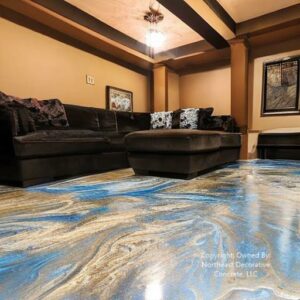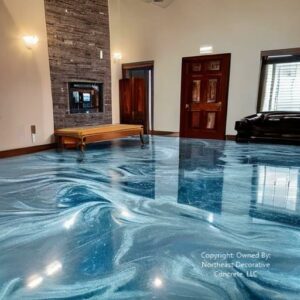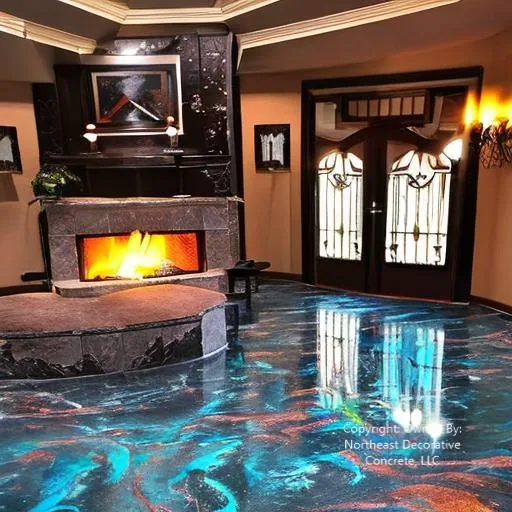
Find out the answer to the question, “Can You Recolor Over Concrete That Has Already Been Stained?” We look at the pros and cons, preparation and application techniques and FAQs to help you decide if it’s right for your project.
Can You Stain Over Concrete That Has Already Been Stained?
Concrete stains offer an excellent solution for existing concrete surfaces! They’ll help you achieve the new look you want while keeping the integrity of your old concrete finish.
Yes. It is possible to change the color over an existing stained stamped concrete patio surface, but the results may not be as even or consistent as with a new concrete floor. Acid stains sink into the concrete pores, so it’s possible to color over acid-stained concrete, but the acid stain would stop any new concrete cementitious coatings from taking hold. If the existing concrete isn’t covered in glue, paint, oil, grease, sealers, waxes, or anything that could stop the dye from sinking in, it should be ready to color.
Before coloring an already-stained floor, it’s crucial to determine the damage to the existing floor and make any necessary repairs. The surface must be clean and free of any debris or contaminants that could contaminate the process. Additionally, any sealants or coatings must be removed, as they can keep the dye from being applied evenly. If the concrete is old, you may need to etch the surface before using the color.
For the best results, using an acid or penetrating solvent-based stain color is best. Acid-based pigments create chemical reactions with the concrete, which gives off different colors, much like dyeing fabric.
What Is The Difference Between Acid Staining And Regular Staining
The primary contrast between acid stained concrete and traditional staining lies in the way they interact with the concrete. Concrete acid coloring is a chemical reaction that alters the concrete’s mineral composition up to a depth of 1/16 inch, resulting in a permanently bonded color onto the concrete that doesn’t chip or peel but must be later covered with a clear coat on the surface of the concrete. Acid pigments come into contact with the top layer of concrete, which is just a fraction of an inch thick, resulting in a unique swirled pattern. The color of the concrete acid dye is determined by the reaction of the acidic solution, which contains metallic salts, with the lime in the concrete.
In contrast, regular water-based staining is a method of coloring older concrete that penetrates deep into the pores and changes its color permanently. Water-based colors are much simpler to apply and don’t require a clear coat like acid-based pigments. They also come in a broader range of colors and require less preparation. In addition, water-based stains provide an even and paint-like shade, with much of the hue coming from acrylics that bond to the concrete surface.

The Process For New Color Staining Over Already Stained Concrete
Assessing the damage to the existing floor and making necessary repairs is the first step to coloring over already pigmented concrete. If the existing color is still intact, the process can begin. It’s essential to ensure the concrete isn’t contaminated with substances that prevent the dye from adequately penetrating the pores, such as glue, paint, oil, grease, sealers, or waxes.
Once the surface is clean and free of any debris, sand it with fine-grit concrete sandpaper to remove imperfections and bumps, thus increasing the bond between concrete and stain. If the surface has been sealed, the sealer needs to be removed first for a successful new coating.
Using either an acid or penetrating solvent is best for the original color best results. Acid-based stains are significant because they create chemical reactions with the outdoor concrete, producing different hues, like dyeing fabric. While applying the color, make sure to keep the surface moist. After the coloring process is complete, an acrylic-based sealant should be applied to protect the surface and bring out the new color of the existing old concrete surface.
In conclusion, the process of staining over already stained surfaces involves:
- Assessing the condition of the existing floor.
- Making necessary repairs.
- Cleaning and sanding the surface.
- Applying the dye.
- Sealing the surface with an acrylic-based sealant.
It’s vital to ensure the previous concrete isn’t contaminated with substances that could prevent the color from penetrating the pores and from using either an acid-based or penetrating solvent-based stain for best results.
The Steps To Prepare The Old Concrete Before Staining
To get your concrete ready for recoloring and sealing, the first thing to do is to give it a good clean. Use a broom or soft nylon bristle brush to sweep away any dirt or debris, or switch on a power washer and give it a low-setting wash. If there are any oil stains, mix up a concrete cleaner and degreaser solution and scrub them away. Once this is done, test the porosity of the concrete by spraying it with water. If the liquid beads up on the surface and doesn’t soak in, sand the area with fine-grit concrete sandpaper or use a concrete etcher to profile the concrete chemically.
If there are little divots or holes, fill them with clear epoxy after coloring and neutralizing them. Before you start coloring, remove all existing sealers, paint, adhesives, and coatings. Finally, the concrete must be porous enough to take on the water for the best staining results.
Steps Involved:
1. Remove any existing sealer or paint from the concrete.
2. Clean the surface of dirt and debris with a mild detergent and a pressure washer.
3. Neutralize the surface with an acid-based concrete etcher.
4. Rinse the surface with a pressure washer and allow it to dry thoroughly.
5. Patch any holes or cracks in the concrete with a concrete repair product.
6. Prime the surface with a concrete sealer or primer designed for concrete staining.
7. Apply concrete pigment with a brush, roller, or sprayer.
8. Allow the dye to dry completely.
9. Seal the colored concrete paint with a concrete slab acrylic sealer.

The Pros of Staining Over Previous Concrete Sealer
What are the pros and cons of staining over previous concrete, they can be a great way to update the look of a space without tearing out the older concrete. It’s also a relatively easy and inexpensive way to change the look of a space.
The Cons of Staining Over Previous Concrete Floor
Staining over previous concrete can be tricky, and awareness of the potential pitfalls is essential. For example, if the older concrete is not properly prepared, the new dye may not adhere correctly. Additionally, depending on the type of existing dye, the new color may not be able to penetrate the surface, resulting in a less durable finish.
Concrete Stain Preparation and Application Techniques
Before beginning the staining process, it’s essential to ensure the surface is properly prepared. First, any existing sealers or coatings should be removed. This can be done with a pressure washer or a chemical stripper. Once the surface is clean, it’s essential to ensure there is no dust or debris on the surface. This can be done with a broom or a vacuum.
Once the surface is clean and debris-free, it’s time to apply the colorant. The type of color that is chosen will determine the application technique. For example, some colors may need to be mixed with a bonding agent or sealer, while others may need to be applied with a roller or a brush.

FAQs:
Q: Can You Stain Over Existing Stained Cement?
A: Yes. Staining over concrete that has already been colored is possible. However, it is vital to ensure the existing surface is properly prepared before applying the new pigment.
Q: What Type Of Stain Should I Use?
A: The type of pigment you should use will depend on the look you are trying to achieve. Different dyes will produce different results, so it’s essential to research the different types of stains and choose the one that is right for your project.
Q: How Do You Stain Already Stained Cementous Finishes?
A: If you want to recolor already stained cement, use a concrete etching solution to remove the existing color. Once the current color is removed, you can apply a new pigment. Be sure to use the appropriate protective gear when working with etching solutions.
Q: What Can You Put Over Stained Concrete?
A: You cut put a sealer, paint, epoxy, carpet, tile, wood, laminate, vinyl, and rubber over stained finishes.
Q: Can You Stain Concrete After It Has Been Sealed?
A: Yes, it is possible to apply the stain after it has been sealed, however, the results may not be as vibrant as if the concrete had not been sealed. It is generally recommended to test a small area first to ensure satisfactory results.
Our Locations:
Nashua, NH
North Hampton, NH
Concord, NH

